#diary of a broken record ✰ watson
Text

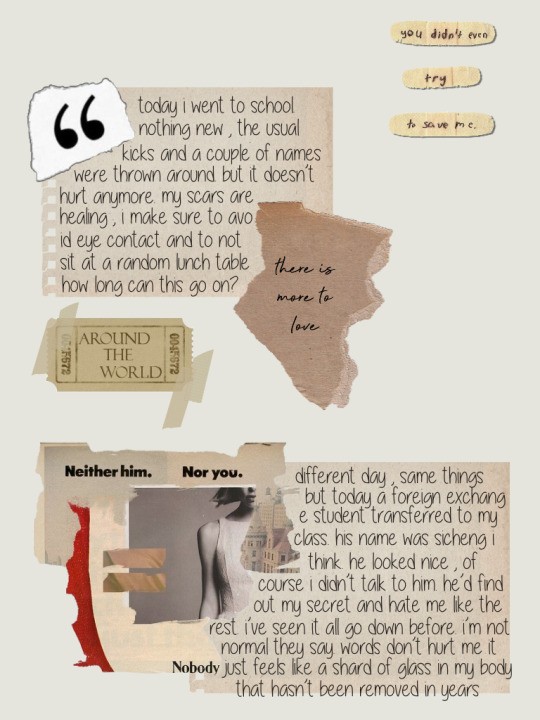


#diary of a broken record ✰ watson#kpop!oc#kpop!au#kpop!addition#kpop!fakegroup#kpop male additions#kpop female addition#kpop oc#kpop au#kpop imagines#kpop aesthetic#male!addition#male!kpop#male!oc
11 notes
·
View notes
Text
Streaming on Plex: Best Movies and TV Shows You Can Watch for FREE in September
https://ift.tt/eA8V8J
This article is sponsored by Plex. You can download the Free Plex App now by clicking here!
There’s an overwhelming amount of new movies and TV shows hitting streaming services this fall. If you’re starving for new content, it’s set to be a fantastic time, but if your wallet is starving for funds, it can be pretty stressful. With studios and content providers spreading their libraries out across so many different streaming services, keeping up with all of your favorites can get expensive. Thankfully, Plex TV is here to keep you entertained without breaking the bank.
Plex is a globally available one-stop-shop streaming media service offering thousands of free movies and TV shows and hundreds of free-to-stream live TV channels, from the biggest names in entertainment, including Metro Goldwyn Mayer (MGM), Warner Bros. Domestic Television Distribution, Lionsgate, Legendary, AMC, A+E, Crackle, and Reuters. Plex is the only streaming service that lets users manage their personal media alongside a continuously growing library of free third-party entertainment spanning all genres, interests, and mediums including podcasts, music, and more. With a highly customizable interface and smart recommendations based on the media you enjoy, Plex brings its users the best media experience on the planet from any device, anywhere.
Plex releases brand new and beloved titles to its platform monthly and we’ll be here to help you identify the cream of the crop. View Plex TV now for the best free entertainment streaming and check back each month for Den of Geek Critics’ picks!
cnx.cmd.push(function() { cnx({ playerId: "106e33c0-3911-473c-b599-b1426db57530", }).render("0270c398a82f44f49c23c16122516796"); });
DEN OF GEEK CRITICS’ PICKS
Teenage Mutant Ninja Turtles
They’re the world’s most fearsome fightin’ team. They’re heroes in a half-shell and they’re green. I mean, what more do we need to say? 2014’s Teenage Mutant Ninja Turtles is no Citizen Kane, but comic book movie fans flock to it like the four titular turtles to pizza. The film knows exactly what it is, providing cheesy one-liners, silly action, and unpretentious fun. Throwing in Will Arnett as a sidekick for April O’Neil was an inspired choice that paid dividends in laughs and whoever tapped Tony Shaloub to voice Splinter should get a pay raise. Produced by Nickelodeon Pictures, Teenage Mutant Ninja Turtles wasn’t only the highest grossing film in the series, but also the highest grossing Nickelodeon film of all-time. This reboot of the classic ninja team helped spawn further films, new TV series, and a renewed interest in one of the most beloved comic book properties ever. Cowabunga, dude!
Noah
This isn’t your Sunday School’s Noah. Darren Aronofsky’s adaptation of the story of the biblical figure Noah is an awe-inspiring epic that takes the bones of the famous story and infuses themes about environmentalism, self-doubt, and yes, faith. Pulling liberally from texts like the Book of Enoch, the film has far more action than just leading animals onto a boat and a storm. Shot by Matthew Libatique, the movie looks absolutely gorgeous and at times can be genuinely breath-taking, but it’s not just about the visuals. Russell Crowe stuns in the title role, but the entire ensemble is great, including a post-Potter Emma Watson and a ferocious Ray Winstone. No one expected Noah to be more akin to a thought-provoking art house film than a straight-forward epic, but that’s the sort of genius you get from Aronofsky, one of the most exciting and inventive filmmakers working today.
Shine a Light
Even if we hadn’t just lost the immortal, suave Charlie Watts, the heartbeat of rock and roll’s longest institution, The Rolling Stones, we’d still be recommending Martin Scorsese’s Shine a Light. Capturing the legendary band during their A Bigger Bang Tour in 2006, Scorsese spends a lot of the time rightfully focusing on Watts. With the camera fixated on Watts, you witness his unflappability; the way that he can make such raucous playing look so effortless. You also catch the man’s unique, jazz-influenced technique, like how he rarely hits the center of his snare, or how he changes his grip whenever he hits a cymbal. Even in their old age, the Stones are still one of the tightest, most electrifying live acts, and Shine a Light puts you right on stage with them as they barrel through one of the deepest catalogs in recorded music. It’s simply a masterful concert film.
The Virgin Suicides
Sofia Coppola likely has to deal with accusations about nepotism to this day, but anyone who saw her directorial debut The Virgin Suicides knows that Francis’ daughter would have made it as a filmmaker even without her famous last name. This haunting adaptation of Jeffrey Eugenides’ novel of the same name taps into the melancholy of childhood, the dreamlike haze of memory, and the mystery that lurks inside suburban homes. Coppola expertly captures the pull that an ethereal group of sisters have on the imaginative group of boys that pine for them in a way that is relatable for anyone that had an unrequited crush in high school. As a coming-of-age movie, it is one of a kind. As an exploration of trauma and grief, it is crushingly effective. The original score by the band Air only adds to its hypnagogic vibe.
Rock ‘n’ Roll High School
Punk rock music and Roger Corman pictures are some of the core tenants that Den of Geek was founded on, so of course we’re going to recommend 1979’s Rock ‘n’ Roll High School, which features possibly the coolest band of all-time, The Ramones. Let our resident punk rock movie expert Jim Knipfel break it down for you:
“After producing so many dozens of teen rebellion films over the years, Corman finally hit the pinnacle, the ultimate teen rebellion picture, with the cartoon antics ratcheted up more than a few notches. There are so many bad jokes flying around, so many visual gags and film references packed into every scene, so many overwrought teen film clichés pushed way past absurd, it’s a film that demands multiple viewings. Even if “Riff Randall, rock ’n’ roller” (P.J. Soles) doesn’t look much like any punk chick I ever knew, I’m perfectly willing to accept it. And in historical terms, it really was this film more than the 4 albums they had out at the time that spread the word about The Ramones to mainstream America, and that’s worth something. Old as I am I still get a thrill every time the students and the Ramones blow up Vince Lombardi High, and anyone who doesn’t must be wrong in the head somehow.”
New on Plex in September:
1000 Times Good Night
13
13 Assassins
The Accidental Husband
All Good Things
Assassination of a High School President
Awake
Bent
Bordertown
Brain Dead
Cold Mountain
The Descent
The Descent Part 2
Even Money
Fear City
First Snow
Freedom Writers
Gray Matters
The Jesus Rolls
Johnny Was
Keys to Tulsa
The Legend of Bagger Vance
Mad Money
Marrowbone
Murder on the Orient Express
The Ninth Gate
Nothing but the Truth
Ordinary People
Rememory
Rock ‘n’ Roll High School
Sanctuary
Shine a Light
Soul Survivors
Taboo
Teenage Mutant Ninja Turtles
The TV Set
The Virgin Suicides
What Doesn’t Kill You
Winter Passing
World Trade Center
Catch before it leaves in September:
31
Absolution
Accident Man
Aeon Flux
After.Life
Angel of Death
Answer Man
The Bang Bang Club
Battle Royale
Blood and Bone
The Broken
Cashmere Mafia
Child 44
Cleaner
Cold Comes the Night
Coming Soon
The Connection
Conspiracy
The Cookout
Critical Condition
Dark Crimes
The Death and Life of Bobby Z
Death Proof
Dickie Roberts: Former Child Star
Downhill Racer
Dragged Across Concrete
The Dresser
The Duel
Dummy
Flight of Fury
Flirting with Disaster
The Foreigner
Goat
Gutshot Straight
Halloween III: Season of the Witch
The Hard Corps
Hesher
High Right
Honeymoon
The Hunt
I Saw the Devil
In the Mix
Jason and the Argonauts
Jeff, Who Lives at Home
Jiri Dreams of Sushi
Joe
Journey to the West
Kill ‘Em All
A Kind of Murder
The Kite Runner
Lake Placid 2
Lake Placid 3
Last Resort
The Lazarus Project
Misconduct
Mr. Church
Mutant Chronicles
Mythica: The Godslayer
Mythica: The Iron Clown
Never Back Down: No Surrender
News Radio
Noah
Ong Bak: The Thai Warrior
Ong Bak: The Beginning
The Order
Out for a Kill
The Outcasts
Phantoms
Pistol Whipped
The Protector
Pulse (2001)
Reprisal
Return to the Blue Lagoon
The River Murders
The Romantics
Second in Command
Shadow Man
Shattered
The Shepherd
Southside with You
Space Station 76
Square Pegs
Standoff
Starship Troopers 2: Hero of the Federation
Starship Troopers 3: Marauder
Steel Dawn
Substitute
The Super
SWAT: Under Siege
The Terminal
The Three Burials of Melquiades Estrada
Touchy Feely
Trollhunter
UFO
Universal Solider: Day of Reckoning
Vamps
Vicky Cristina Barcelona
Walking Tall: Lone Justice
Warlock
What Planet are You From?
World’s Fastest Indian
World’s Greatest Dad
The Yellow Handkerchief
Still streaming on Plex:
2:22
2 Days in New York
21 Jump Street
22 Bullets
24 Hours to Live
3rd Rock from the Sun
6 Bullets
99 Homes
A Little Bit of Heaven
A Walk in the Woods
The Air I Breathe
Alan Partridge
ALF
Alone in the Dark
Amelie
American Pastoral
And Soon the Darkness
Andromeda
Are You Here
Arthur and the Invisibles
Awake
Battle in Seattle
Bernie
Better Watch Out
Black Death
Blade of the Immortal
Blitz
The Brass Teapot
Bronson
The Brothers Bloom
The Burning Plain
But I’m a Cheerleader
Cake
Candy
Catch .44
Cell
The Choice
Clerks II
Coherence
The Collector
Colonia
Congo
Cooties
The Core
The Cotton Club
Crossing Lines
Croupier
Cube
Cube 2
Cube Zero
Cyrano de Bergerac
Death and the Maiden
The Deep Blue Sea
Deep Red
Derailed
Detachment
The Devil’s Rejects
Diary of the Dead
District B13
DOA: Dead or Alive
Dr. T and the Women
Eden Lake
The Edge of Love
The post Streaming on Plex: Best Movies and TV Shows You Can Watch for FREE in September appeared first on Den of Geek.
from Den of Geek https://ift.tt/3DV4bW5
1 note
·
View note
Text
What We Can Learn From 1918 Influenza Diaries
https://sciencespies.com/nature/what-we-can-learn-from-1918-influenza-diaries/
What We Can Learn From 1918 Influenza Diaries
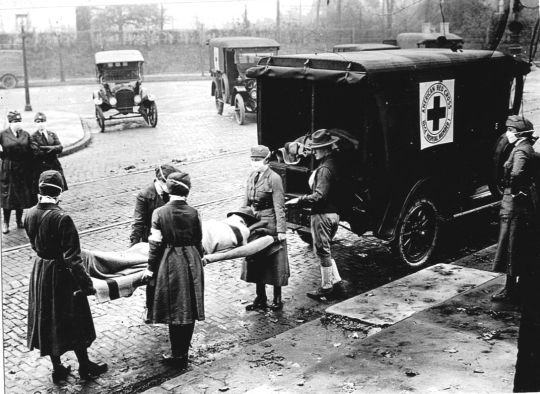
SMITHSONIANMAG.COM |
April 13, 2020, 8 a.m.
When Dorman B.E. Kent, a historian and businessman from Montpelier, Vermont, contracted influenza in fall 1918, he chronicled his symptoms in vivid detail. Writing in his journal, the 42-year-old described waking up with a “high fever,” “an awful headache” and a stomach bug.
“Tried to get Dr. Watson in the morning but he couldn’t come,” Kent added. Instead, the physician advised his patient to place greased cloths and a hot water bottle around his throat and chest.
“Took a seidlitz powder”—similar to Alka-Seltzer—“about 10:00 and threw it up soon so then took two tablespoons of castor oil,” Kent wrote. “Then the movements began and I spent a good part of the time at the seat.”
The Vermont historian’s account, housed at the state’s historical society, is one of countless diaries and letters penned during the 1918 influenza pandemic, which killed an estimated 50 to 100 million people in just 15 months. With historians and organizations urging members of the public to keep journals of their own amid the COVID-19 pandemic, these century-old musings represent not only invaluable historical resources, but sources of inspiration or even diversion.
“History may often appear to our students as something that happens to other people,” writes Civil War historian and high school educator Kevin M. Levin on his blog, “but the present moment offers a unique opportunity for them to create their own historical record.”

Members of the Red Cross Motor Corps, all wearing masks to prevent the further spread of the influenza epidemic, carry a patient on a stretcher into their ambulance, Saint Louis, Missouri, October 1918.
(Photo by PhotoQuest / Getty Images)
The work of a historian often involves poring through pages upon pages of primary source documents like diaries—a fact that puts these researchers in a position to offer helpful advice on how prospective pandemic journalers might want to get started.
First and foremost, suggests Lora Vogt of the National WWI Museum and Memorial, “Just write,” giving yourself the freedom to describe “what you’re actually interested in, whether that’s your emotions, [the] media or whatever it is that you’re watching on Netflix.”
Nancy Bristow, author of American Pandemic: The Lost Worlds Of The 1918 Influenza Epidemic, advises writers to include specific details that demonstrate how “they fit into the world and … the pandemic itself,” from demographic information to assessment of the virus’ impact in both the public and personal spheres. Examples of relevant topics include the economy; political messaging; level of trust in the government and media; and discussion of “what’s happening in terms of relationships with family and friends, neighbors and colleagues.”
Other considerations include choosing a medium that will ensure the journal’s longevity (try printing out entries written via an electronic journaling app like Day One, Penzu or Journey rather than counting on Facebook, Twitter and other social media platforms’ staying power, says Vogt) and defying the sense of pressure associated with the need to document life during a “historic moment” by simply writing what comes naturally.
Journaling “shouldn’t be forced,” says Levin. “There are no rules. It’s really a matter of what you take to be important.”
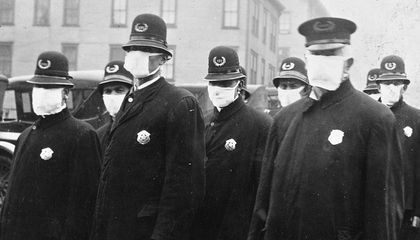
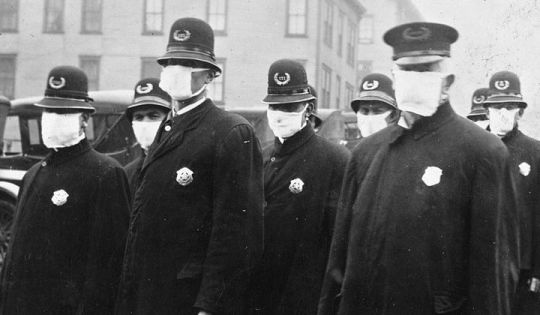
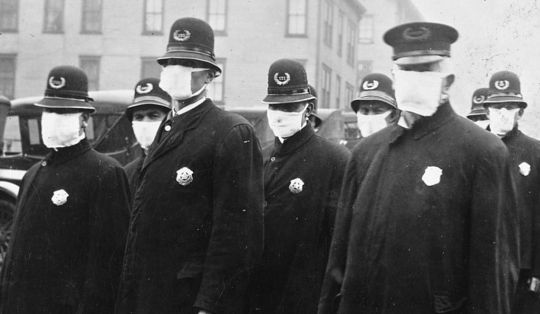

Seattle police officers wearing masks in 1918
(Public domain via Wikimedia Commons)
If all else fails, look to the past: specifically, the nine century-old missives featured below. Though much has changed since 1918, the sentiments shared in writings from this earlier pandemic are likely to resonate with modern readers—and, in doing so, perhaps offer a jumping-off point for those navigating similar situations today.
Many of these journalers opted to dedicate space to seemingly mundane musings: descriptions of the weather, for instance, or gossip shared by friends. That these quotidian topics still manage to hold our attention 100 years later is a testament to the value of writing organically.
State historical societies are among the most prominent record-keepers of everyday people’s journals and correspondence, often undertaking the painstaking tasks of transcribing and digitizing handwritten documents. The quotes featured here—drawn in large part from local organizations’ collections—are reproduced faithfully, with no adjustments for misspelling or modern usage.
Edith Coffin (Colby) Mahoney
From the Massachusetts Historical Society
Between 1906 and 1920, Edith Coffin (Colby) Mahoney of Salem, Massachusetts, kept “three line-a-day diaries” featuring snippets from her busy schedule of socializing, shopping and managing the household. Most entries are fairly repetitive, offering a simple record of what Mahoney did and when, but, on September 22, 1918, she shifted focus to reflect the pandemic sweeping across the United States.
Fair & cold. Pa and Frank here to dinner just back from Jefferson Highlands. Rob played golf with Dr. Ferguson and Mr. Warren. Eugene F. went to the hospital Fri. with Spanish influenza. 1500 cases in Salem. Bradstreet Parker died of it yesterday. 21 yrs old.

September 24, 1918, diary entry
(Collection of the Massachusetts Historical Society)
Four days later, Mahoney reported that Eugene had succumbed to influenza. “Several thousand cases in the city with a great shortage of nurses and doctors,” she added. “Theatres, churches, gatherings of everykind stopped.”
Mahoney’s husband, Rob, was scheduled to serve as a pallbearer at Eugene’s September 28 funeral, but came down with the flu himself and landed “in bed all day with high fever, bound up head and aching eye balls.”
By September 29—a “beautiful, mild day,” according to Mahoney—Rob was “very much better,” complaining only of a “husky throat.” The broader picture, however, remained bleak. Another acquaintance, 37-year-old James Tierney, had also died of the flu, and as the journal’s author noted, “Dr says there is no sign of epidemic abating.”
Franklin Martin
From the National Library of Medicine, via research by Nancy Bristow
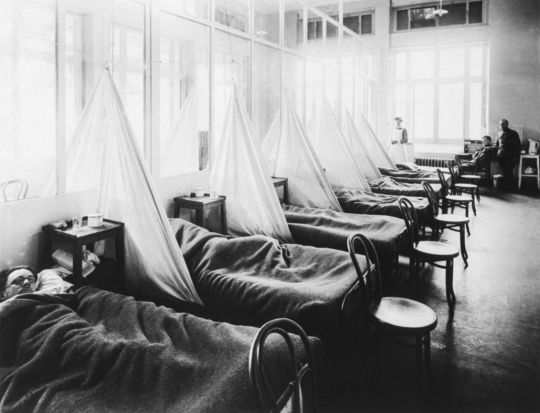
Patients at a U.S. Army ward in France
(© Corbis via Getty Images)
In January 1919, physician Franklin Martin fell ill while traveling home from a postwar tour of Europe. His record of this experience, written in a journal he kept for his wife, Isabelle, offers a colorful portrait of influenza’s physical toll.
Soon after feeling “chilly all day,” Martin developed a 105-degree fever.
About 12 o’clock I began to feel hot. I was so feverish I was afraid I would ignite the clothing. I had a cough that tore my very innards out when I could not suppress it. It was dark; I surely had pneumonia and I never was so forlorn and uncomfortable in my life. … Then I found that I was breaking into a deluge of perspiration and while I should have been more comfortable I was more miserable than ever.
Added the doctor, “When the light did finally come I was some specimen of misery—couldn’t breathe without an excruciating cough and there was no hope in me.”
Martin’s writing differs from that of many men, says Bristow, in its expression of vulnerability. Typically, the historian explains, men exchanging correspondence with each other are “really making this effort to be very brave, … always apologizing for being sick and finding out how quickly they’ll be back at work, or [saying] that they’re never going to get sick, that they’re not going to be a victim of this.”
The physician’s journal, with its “blow-by-blow [treatment] of what it was like to actually get sick,” represents a “really unusually profound” and “visceral” point of view, according to Bristow.
Violet Harris
Violet Harris was 15 years old when the influenza epidemic struck her hometown of Seattle. Her high school diaries, recounted by grandniece Elizabeth Weise in a recent USA Today article, initially reflect a childlike naivete. On October 15, 1918, for example, Harris gleefully reported:
It was announced in the papers tonight that all churches, shows and schools would be closed until further notice, to prevent Spanish influenza from spreading. Good idea? I’ll say it is! So will every other school kid, I calculate. … The only cloud in my sky is that the [School] Board will add the missed days on to the end of the term.

A Seattle streetcar conductor refuses entry to a commuter who is not wearing a mask in December 1918.
(Photo by PhotoQuest / Getty Images)
Before long, however, the enormity of the situation sank in. The teenager’s best friend, Rena, became so sick she “could hardly walk.” When Rena recovered, Harris asked her “what it felt like to have the influenza, and she said, ‘Don’t get it.’”
Six weeks after Seattle banned all public gatherings, authorities lifted restrictions, and life returned to a semblance of normal. So, too, did Harris’ tone of witty irreverence. Writing on November 12, she said:
The ban was lifted to-day. No more …. masks. Everything open too. ‘The Romance of Tarzan’ is on at the Coliseum [movie theater] as it was about 6 weeks ago. I’d like to see it awfully. …. School opens this week—Thursday! Did you ever? As if they couldn’t have waited till Monday!
N. Roy Grist

Panoramic view of Fort Devens in 1918
(Courtesy of the Fort Devens Museum)
Fort Devens, a military camp about 40 miles from Boston, was among the sites hardest hit by the 1918 influenza epidemic. On September 1, some 45,000 soldiers waiting to be deployed to France were stationed at the fort; by September 23, according to the New England Historical Society, 10,500 cases of the flu had broken out among this group of military men.
Physician N. Roy Grist described the devastation to his friend Burt in a graphic September 29 letter sent from Devens’ “Surgical Ward No. 16.”
These men start with what appears to be an attack of la grippe or influenza, and when brought to the hospital they very rapidly develop the most viscous type of pneumonia that has ever been seen. Two hours after admission they have the mahogany spots over the cheek bones, and a few hours later you can begin to see the cyanosis extending from their ears and spreading all over the face, until it is hard to distinguish the coloured men from the white. It is only a matter of a few hours then until death comes, and it is simply a struggle for air until they suffocate. It is horrible. One can stand it to see one, two or twenty men die, but to see these poor devils dropping like flies sort of gets on your nerves.
On average, wrote the doctor, around 100 patients died each day.




Nurses at Fort Devens in 1918
(Courtesy of the Fort Devens Museum)
Grist’s letter is “a remarkably distinct and accurate description of what it was like to be in the midst of this,” says Bristow. “And then it goes on to talk about how difficult it is to be a doctor, … this sense of not being able to do as much as one might like and how exhausting it all is.”
Toward the end of the letter, Grist notes how much he wishes Burt, a fellow physician, was stationed at Fort Devens with him.
It’s more comfortable when one has a friend about. … I want to find some fellow who will not ‘talk shop’ but there ain’t none, no how. We eat it, sleep it, and dream it, to say nothing of breathing it 16 hours a day. I would be very grateful indeed if you would drop me a line or two once in a while, and I promise you that if you ever get into a fix like this, I will do the same for you.
Clara Wrasse
From the National WWI Museum and Memorial
In September 1918, 18-year-old Clara Wrasse wrote a letter to her future husband, Reid Fields, an American soldier stationed in France. Though her home city of Chicago was in the midst of battling an epidemic, influenza was, at best, a secondary concern for the teenager, who reported:
About four hundred [people] died of it at the Great Lakes … quite a number of people in Chi are suffering with it too. Mother thought that I had it when I wasn’t feeling good, but I am feeling fine now.
Quickly moving on from this mention of disease, Wrasse went on to regale her beau with stories of life in Chicago, which she deemed “to be the same old city, altho there are lots of queer things happening.”
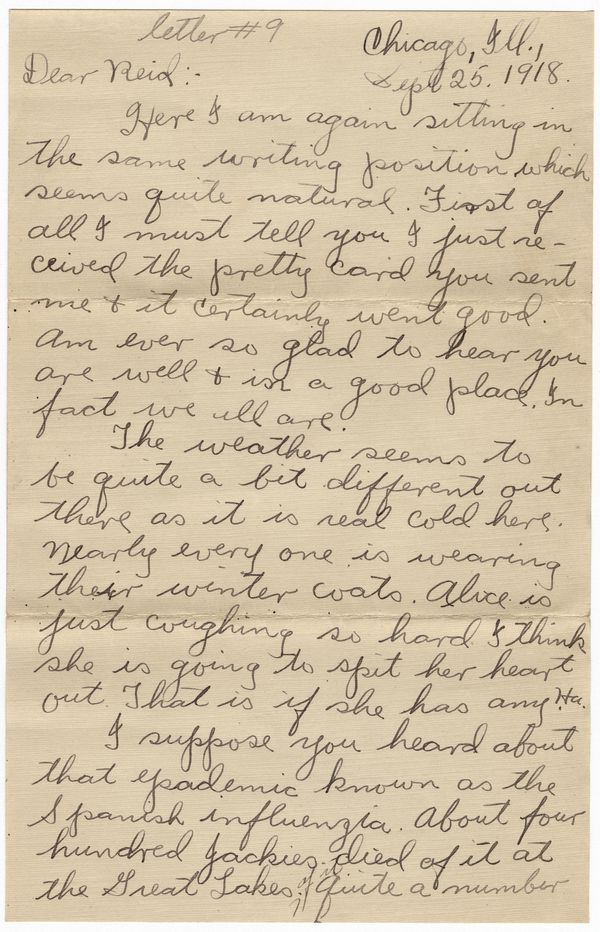
September 25, 1918, letter from Clara Wrasse to Reid Fields
(National World War I Museum and Memorial)
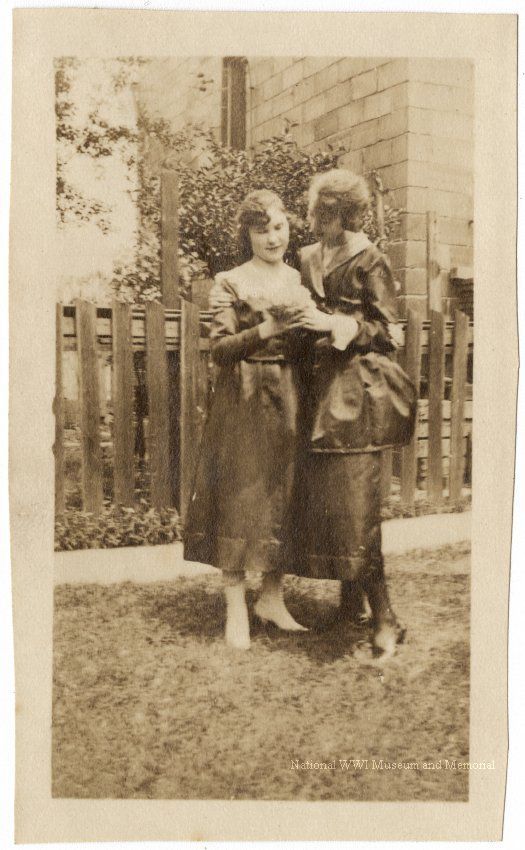
Wrasse is believed to be one of the two women pictured here.
(Courtesy of the National World War I Museum)
Signing off with the lines “hoping you feel as happy as you did when we played Bunco together,” Wrasse added one last postscript: “Any time you haven’t got anything to do, drop me a few lines, as I watch for a letter from you like a cat watches a mouse.”
Vogt of the National World War I Museum cites Wrasse’s letters as some of her favorites in the Kansas City museum’s collections.
“It’s so clear how similar across the ages teenagers are and what interests them,” she says, “and that … they’re kind of wooing each other in these letters in a way that a teenager would.”
Leo Baekeland
From the Smithsonian’s National Museum of American History
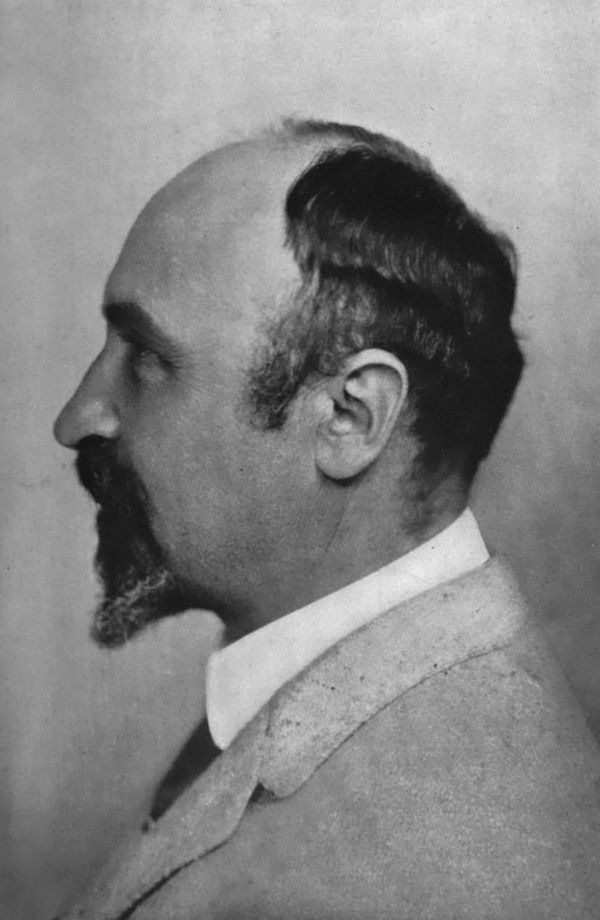
Leo Baekeland, inventor of the first commercialized plastic
(Public domain via Wikimedia Commons)
Inventor Leo Baekeland, creator of the world’s first commercialized plastic, “documented his life prolifically” in diaries, laboratory notebooks, photographs and correspondence, according to the museum’s archives center, which houses 49 boxes of the inventor’s papers.
Baekeland’s fall 1918 journal offers succinct summaries of how the epidemic affected his loved ones. On October 24, he reported that a friend named Albert was sick with influenza; by November 3, Albert and his children were “better and out of bed, but now [his] wife is sick with pneumonia.” On November 10, the inventor simply stated, “Albert’s wife is dead”—a to-the-point message he echoed one week later, when he wrote that his maid, Katie, was “buried this morning.”
Perhaps the most expressive sentiment found among Baekeland’s entries: “From five who had influenza, two deaths!”
Dorman B.E. Kent
From the Vermont Historical Society

Dorman B.E. Kent’s diary
(Courtesy of the Vermont Historical Society)
From the age of 11 to his death at 75 in 1951, Dorman B.E. Kent recorded his life in diaries and letters. These papers—now held by the Vermont Historical Society, where Kent served as a librarian for 11 years—document everything from his childhood chores to his views on Franklin Delano Roosevelt’s New Deal and his sons’ career progress.
Of particular interest is Kent’s fall 1918 diary, which contains vivid descriptions of his own bout with influenza. On September 24, he wrote (as mentioned above):
Awoke at 7:00 [a.m.] sick, sick, sick. Didn’t get up or try to. Had a high fever an awful headache every minute all day and was sick to my stomach also. Tried to get Dr. Watson in the morning but he couldn’t come. Told us instead what to do. Greased cloths with inflamacene all day and put around throat and chest and held a bottle of hot water at throat most of the time. Took a seidlitz powder about 10.00 and threw it up soon so then took two tablespoons of castor oil. Then the movements began and I spent a good part of the time at the seat … There is a tremendous lot of influenza in town.
Kent recovered within a few days, but by the time he was able to resume normal activities, his two sons had come down with the flu. Luckily, all three survived the illness.
In early October, Kent participated in a door-to-door census count of the disease’s toll. Surveying two wards in Montpelier on October 2, he and his fellow volunteers recorded 1,237 sick in bed, 1,876 “either ill or recovered,” and 8 dead in one night. The following day, Kent reported that “25 have died in Barre today & the conditions are getting worse all the while. … Terrible times.”
Donald McKinney Wallace
From the Wright State University Special Collections and Archives
Partially transcribed by Lisa Powell of Dayton Daily News
Donald McKinney Wallace, a farmer from New Carlisle, Ohio, was serving in the U.S. Army when the 1918 pandemic broke out. The soldier’s wartime diary detailed conditions in his unit’s sick bay—and the Army’s response to the crisis. On September 30, Wallace wrote:
Layed in our sick ward all day but am no better, had a fever all day. This evening the Doctor had some beef broth brought down to us which was the first I had eaten since last Fri. Our ward was fenced off from rest of the barrack by hanging blankets over a wire which they stretched clear across the ceiling.
On October 4, the still-ailing farmer added, “Not a bit well yet but anything is better than going over to the hospital. 2 men over there have Spanish Influenza bad and are not expected to live. We washed all windows and floors with creoline solution tonight.”

Donald McKinney Wallace’s September 30, 1918, diary entry
(Wright State University Special Collections and Archives)
Wallace survived his illness (and the war), dying in 1975 at age 78.
Though Wallace’s writings don’t reference the situation in his hometown, Bristow notes that many soldiers expressed concern for their families in correspondence sent from the front.
“You get these letters from soldiers who are so worried about their families at home,” she says, “and it’s not what anyone had expected. Their job was to go off soldiering, and the family would worry about them. And now, suddenly, the tables are turned, and it’s really unsettling.”
Helen Viola Jackson Kent
From Utah State University’s Digital History Collections
When Helen Viola Jackson Kent’s children donated her journals to Utah State University, they offered an apt description of the purpose these papers served. Like many diary writers, Kent used her journal to “reflect her daily life, her comings and goings, her thoughts, her wishes, her joys, and her disappointments.”
On November 1, 1918, the lifelong Utah resident wrote that she “[h]ad a bad head ache all day and did not accomplish much. Felt very uneasy as I found out I was exposed to the ‘flu’ Wed. at the store.”
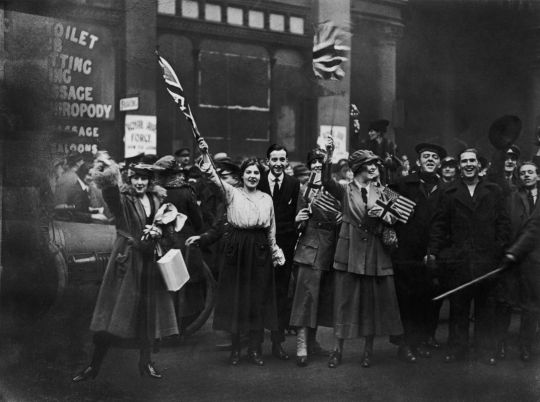
Armistice Day celebrations inadvertently spread influenza.
(Photo by Topical Press Agency / Getty Images)
Kent escaped the flu, but her husband, Melvin—called “Mell” in her diary—was not so lucky. Still, Melvin managed to make a full recovery, and on November 18, his wife reported:
Mell much better and dressed today. Almost worn out with worry and loss of sleep. So much sickness and death this week, but one great ray of light and hope on the outcome of the war as peace came this past [11th].
Interestingly, Kent also noted that the celebrations held to mark the end of World War I had sparked an inadvertent uptick in illness.
“On account of the rejoicing and celebrating,” she wrote, “this disease of influenza increased everywhere.”
#Nature
1 note
·
View note
Photo

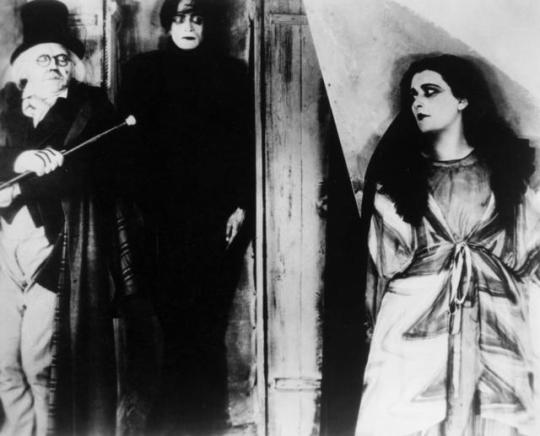
The Cabinet of Dr. Caligari and Sherlock
TAB
At the stately home of the Carmichaels, Sir Eustace is standing near the fireplace of a large drawing room. Watson stands facing him while Holmes is pacing around the room.
SIR EUSTACE: Somnambulism.
WATSON: I beg your pardon?
SIR EUSTACE: I sleepwalk, that’s all. It’s a common enough condition. I thought you were a doctor. The whole thing was a bad dream.
WATSON: Including the contents of the envelope you received?
(Sir Eustace tries to laugh.)
SIR EUSTACE: Well, that’s a grotesque joke.
WATSON: Well, that’s not the impression you gave your wife, sir.
SIR EUSTACE: She’s an hysteric, prone to fancies.
HOLMES: No.
SIR EUSTACE: I’m sorry? What did you say?
HOLMES (finally stopping his pacing): I said no, she’s not an hysteric. She’s a highly intelligent woman of rare perception.
SIR EUSTACE: My wife sees terror in an orange pip.
HOLMES (walking closer): Your wife can see worlds where no-one else can see anything of value whatsoever.
SIR EUSTACE (sarcastically): Can she really? And how do you ‘deduce’ that, Mr Holmes?
HOLMES: She married you.
Fast forward...
WATSON: Well, he’s been stabbed with considerable force.
LESTRADE: It’s a man, then.
WATSON: Possibly.
LESTRADE: A very keen blade, so it could conceivably have been a woman.
WATSON (angrily standing up and walking back to the other two): In theory, yes, but we know who it was. I saw her.
HOLMES: Watson.
WATSON (loudly): I saw the ghost with my own eyes.
HOLMES (angrily): You saw nothing. You saw what you were supposed to see.
WATSON: You said yourself: I have no imagination.
HOLMES: Then use your brain, such as it is, to eliminate the impossible – which in this case is the ghost – and observe what remains – which in this case is a solution so blindingly obvious, even Lestrade could work it out.
LESTRADE: Thank you(!)
HOLMES (angrily, to Watson): Forget spectres from the otherworld. (More calmly) There is only one suspect with motive and opportunity. They might as well have left a note.
LESTRADE: They did leave a note.
HOLMES (to Watson): And then there’s the matter of the other broken window.
LESTRADE: What other broken window?
HOLMES: Precisely. There isn’t one. The only broken window in this establishment is the one that Watson and I entered through, yet prior to that we distinctly heard the sound of What did you just say?
LESTRADE: Sorry?
HOLMES: About a note. What did you just say?
LESTRADE: I said the murderer did leave a note.
HOLMES: No they didn’t.
LESTRADE: There’s a message tied to the dagger. You must have seen it!
HOLMES (walking towards the body): There’s no message.
LESTRADE: Yes!
HOLMES: There was no message when I found the body.
(He stops and looks down at Sir Eustace’s corpse. Looped around the hilt of the dagger is a piece of string, to which is attached a luggage label. He squats down, picks up the label and looks at the underside. His eyes widen and he lowers the label back down onto Sir Eustace’s chest. Staring into the distance in disbelief, he slowly stands up.)
WATSON: Holmes?
(He walks closer as Holmes slowly backs away, then turns and walks slowly towards the stairs.)
WATSON: What is it?
(Not answering, Holmes heads down the stairs. Watson walks over to the body, squats down and lifts the luggage label and looks at the underside. Written in large letters is:
MISS ME? ( x )
The luggage label indicating mental baggage, like most of TAB.

Gatiss: The Cabinet of Dr. Caligari was ambitious, and startingly original, and it’s cast a shadow over cinema ever since. The film is the story of a sleepwalking killer who is manipulated to fulfill the murderous urges of his own psychiatrist. Caligari boasts some daring narrative twists...subtlety was never an aspiration (of German expressionism). Expressionist art offered a heightened, stylized experience that made inward, psychological states, outwardly visible. That’s what the makers of Caligari hoped to achieve with their set design. The result, is one of cinema’s most distinctive visions.

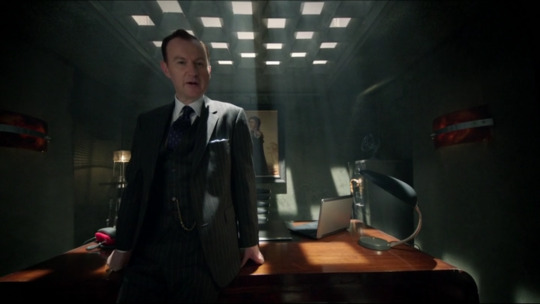



Film Plot
As Francis sits on a bench with an older man who complains that spirits have driven him away from his family and home, a dazed woman named Jane passes them. Francis explains she is his "fiancée" and that they have suffered a great ordeal. Most of the rest of the film is a flashback of Francis's story, which takes place in Holstenwall, a shadowy village of twisted buildings and spiraling streets. Francis and his friend Alan, who are good-naturedly competing for Jane's affections, plan to visit the town fair. Meanwhile, a mysterious man named Dr. Caligari seeks a permit from the rude town clerk to present a spectacle at the fair, which features a somnambulist named Cesare. The clerk mocks and berates Dr. Caligari, but ultimately approves the permit. That night, the clerk is found stabbed to death in his bed.
The next morning, Francis and Alan visit Dr. Caligari's spectacle, where he opens a coffin-like box to reveal the sleeping Cesare. Upon Dr. Caligari's orders, Cesare awakens and answers questions from the audience. Despite Francis's protests, Alan asks, "How long will I live?" To Alan's horror, Cesare answers, "Until dawn." Later that night, a figure breaks into Alan's home and stabs him to death in his bed. A grief-stricken Francis investigates Alan's murder with help from Jane and her father, Dr. Olsen, who obtains police authorization to investigate the somnambulist. (Which is how Lestrade ends up working in an area outside his jurisdiction.) That night, the police apprehend a criminal in possession of a knife who is caught attempting to murder an elderly woman. When questioned by Francis and Dr. Olson, the criminal confesses he tried to kill the elderly woman, but denies any part in the two previous deaths; he was merely taking advantage of the situation to divert blame onto the real murderer. (John needing an alibi, only responsible for Mary’s death.)
At night, Francis spies on Dr. Caligari and observes what appears to be Cesare sleeping in his box. However, the real Cesare sneaks into Jane's home as she sleeps. He raises a knife to stab her, but instead abducts her after a struggle, dragging her through the window onto the street. Chased by an angry mob, Cesare eventually drops Jane and flees; he soon collapses and dies. Francis also confirms that the caught criminal has been locked away and could not have been the attacker. Francis and the police investigate Dr. Caligari's sideshow and realize that the 'Cesare' sleeping in the box is only a dummy. Dr. Caligari escapes in the confusion. Francis follows and sees Caligari go through the entrance of an insane asylum.
Upon further investigation, Francis is shocked to learn that Dr. Caligari is the asylum's director (Pollock, The Governor, Eurus, etc). With help from the asylum staff, Francis studies the director's records and diary while the director is sleeping. The writings reveal his obsession with the story of an 18th-century mystic named Caligari, who used a somnambulist named Cesare to commit murders in northern Italian towns. The director, attempting to understand the earlier Caligari, experiments on a somnambulist admitted to the asylum, who becomes his Cesare. The director screams, "I must become Caligari!" Francis and the doctors call the police to Dr. Caligari's office, where they show him Cesare's corpse. Dr. Caligari then attacks one of the staff. He is subdued, restrained in a straitjacket, and becomes an inmate in his own asylum.

The narrative returns to the present, where Francis concludes his story. In a twist ending, Francis is revealed to actually be an asylum inmate. Jane and Cesare are patients as well; Jane believes she is a queen, while Cesare is not a somnambulist but alive, quiet, and, apparently, not dangerous. The man Francis imagines to be "Dr. Caligari" is in fact the asylum director. Francis attacks him and is restrained in a straitjacket, then placed in the same cell where Dr. Caligari was confined in Francis's story. The director announces that now that he understands Francis's delusion, he is confident he can cure him.
The original manuscript opens on an elegant terrace of a large villa, where Francis and Jane are hosting a party, and the guests insist that Francis tell them a story that happened to him 20 years earlier. The conclusion to the frame story is missing from the script. -Wiki
Worth noting this was the first film to be considered genius for its various plots twists. Also, it has an alternative ending, much like Clue, and how we’re theorizing things will change from how they are perceived in S3 and S4.
@may-shepard @swimmingfeelsinajohnlockianpool @darlingtonsubstitution @sherlockians-get-bored @gosherlocked @princess-of-fireflies @sarahthecoat
45 notes
·
View notes
Text
Episode 97 : In A Project Near You
"Permanent. Physical. Suffering."
- Prodigy
The eighth birthday of the podcast, but a rough month in the world. A last-minute change to the selection for this episode opened up the inclusion of some verses by Prodigy of Mobb Deep, who passed away just a few days ago. On top of the musical tribute, the title and artwork of this episode are inspired by Prodigy quotes from two different cuts - "G.O.D Pt. III" and "Mac 10 Handle" respectively. As always with a birthday episode, I like to break some favourites out, and I think that there are some classic mixes to be heard this month. Let me know what you think!
PS - If you got a copy of the podcast last month (ep.96) with the repeated "pull it up selector" sample before the first voiceover, it got fixed within the first few hours, so if you re-download it's gone. Maybe the broken version is a virtual collector's item? ;)
Playlist/Notes
Nas : The World Is Yours (Tip Mix)
One of the all-time great remixes, and one of a track which was a classic to begin with! Q-Tip comes through with a stripped down beat headlined by absolutely perfect boom-bap drums, and Nas slightly changes the lyrics from the original version heard on "Illmatic". While we're here - everyone who listens to this podcast should have heard "Illmatic" at least once. It's an unmissable landmark.
Non Phixion : 5 Boros (Remix 'Instrumental')
Ok, let me get this out of the way - we DJs don't want your "TV Track". Just give us a plain instrumental, without adlibs and hooks, and we're good. This beat is a prime example of one I'd like a clean copy of - DR Period with an absolute monster which is streets ahead of the Necro-produced original. The vocal version appeared on the show all the way back on episode 13, and it's well worth going back for a listen!
IAM ft. Sunz of Man : La Saga
I think this is one that most people won't know, and understandably so. I came across this on "Yo! MTV Raps" many moons ago and was surprised by two things; firstly, that this French crew had got a Wu-Fam feature at a time when that was a rare thing, and secondly - how amazingly extravagant the video production was! The episode 68 notes alluded to this one, which I was saving for a special occasion. I got this on the "Le Flow" compilation of French Hip-Hop, but it's originally from the album "L'ecole Du Micro L'argent".
Group Home : Up Against The Wall (Getaway Car Mix)
Another classic 90s remix, appearing on one of DJ Premier's finest projects, the debut Group Home album "Livin' Proof". Those drums, that piano - perfection. Group Home might not have been the greatest MCs in the world (although I do think Lil' Dap is generally underrated), this album got the most out of them.
Royal Flush : Can't Help It
A great tune from the "Ghetto Millionaire" album. Prince Kaysaan on the beat bringing some 80s soul flavour to the beat, filtering down to the bassline during the verses in that early-mid 90s style with the slapping drums to match! On the mic, Royal Flush is kind of laid back in the style of a Mic Geronimo, and Khadejia reworks Michael Jackson on the hook. Here for it.
Prodigy : You Can Never Feel My Pain
I almost played this on the show a couple of times this year, but it just didn't fit the mixes. With the passing of Prodigy this month, I asked a few people if they thought it'd be appropriate to include it this episode, and everyone agreed. A great closer to P's first solo album, "H.N.I.C", this is an extraordinary track where he goes in depth about his lifelong battle with Sickle-Cell Anaemia, a blood disease primarily found in Black and other tropic-originating people. The lyrics feature what could be regarded as some shots at 2Pac, which likely stemmed from Pac's entirely unwarranted mocking of Prodigy's illness on "Hit 'Em Up". Ric Rude's production is a great backdrop for an intensely personal song.
Mobb Deep : Temperature's Rising
For most people, it's "Shook Ones, Pt. 2", but this is my personal favourite track on the second (yes, second) Mobb Deep album "The Infamous". Lyrically it's as dark as you'd expect from the Queensbridge duo - based on the true story of Havoc's now late brother, who had been on the run for murder - but musically, it's so smooth. This was Q-Tip at for me, the height of his producing powers, alongside the Mobb. The drums bang hard and then the beautiful Patrice Rushen sample comes in, and Crystal Johnson's hook tops it all off. Prodigy, Havoc, Q-Tip and Crystal created a classic.
Yadava : For Peace
Time to chill things out for a little while! Yadava, resident and co-founder of the Manchester night "So Flute" cooks up something fresh and clean for the "Manchester With Love" compilation, a mammoth gathering of music from the city which is raising money for the Red Cross "We Love Manchester" emergency fund. With a cause like that, and a package of 226 tracks for a minimum donation of £10, I can't recommend highly enough that you get a copy!
Chaka Khan : I Feel For You
Trivia for you - the repeated triggering of Melle Mel saying "Chaka Khan" at the start was a mistake that sounded good, so they stayed with it! This is an absolute monster of a record, with star quality at every turn. For one, Chaka Khan was already a legendary singer at this point, primarily for fronting the funk group Rufus. Featuring in the band, you had some guy called Stevie playing the harmonica (you may have heard of him), and David Frank of The System on the synths. That's not even counting Melle Mel's opening bars. Finally, this song was written by Prince, and actually recorded by him on his second album. Rebbie Jackson and The Pointer Sisters also recorded versions, but which is the one that gets the play? This. Fire.
Suga Free : Hello, Hello, Hello
Sorry Lionel and Adele, but this is in fact the best song with only the word "Hello" in the title ;) "Hello, hello, hello" could easily have been the epigraph for an episode just because of how fly Free's delivery is! Typically outrageous in both ways on the mic, he just slays this old-school flavoured beat from Casino on the "Sunday School" LP.
Clipse ft. Keri Hilson : All Eyes On Me
I cannot work out why this song from "Til The Casket Drops" never got a single release with a video. The Neptunes on production cooked up a beat here which could easily have done well in the clubs, and has been used on many a dance routine! One of the high points of this track is the first line of the hook; I'm not sure if it's intentional, but Keri Hilson delivers it kind of void of emotion - and it works. Maybe it's just me?
Run The Jewels : Call Ticketron
This cut from "RTJ3" has been powering me through skipping (or "jump rope", as some call it) workouts at the gym over the last few months. Crazy hectic, full of energy - if they ever did play at MSG, the place would go nuts over this one!
Miguel Migs ft. Aya : The Distance (Balcazar & Sordo Remix)
The original version of "The Distance" from "Outside The Skyline" is a beauty, and almost got included here, but when I remembered this remix and tried the blend out...it had to be the choice. I do wish they'd used "into the distance" from the original hook here, but that's my only complaint. Aya's vocals are always smooth as silk, and is a great accompaniment to the cold (in a good way), electronic instrumental. Definitely worth checking the remixes release if this kind of thing is your bag!
Trae The Truth : Open Up Tha Trunk
Slow, dark, unnecessarily menacing? Sign me up! Freestyle from the "Another 48 Hours" project by Trae which, as the title suggests, was apparently completed in just two days. Moxiii and Watson The Great come through with an insanely gloomy beat, with the slowed vocal sample for the hook making it sound even more claustrophobic. Teenage me had never heard beats like this, but was trying to make them - would have loved this!
Curren$y : Take You Higher
Cool & Dre go to town with the sample warping and filter tricks right here for the opener of the "Andretti 11/30" mixtape! Curren$y goes with a common theme of his - smoking up and getting lifted. Nothing complicated lyrically, and he cedes control of the track after just one verse to let the producers show off, which is a smart decision. When you've said all there is to say, why not step back?
Corinne Bailey Rae : Taken By Dreams
Leeds! It's been special to see Corinne Bailey Rae's career continue to build, and her latest album, "The Heart Speaks In Whispers" is a worthy addition to her catalogue. I love the way this track opens as a quite acoustic number, then brings in a wave of other elements before settling back into stillness at the end; great production by Corinne and Steven Brown. And if you ever get chance to see her perform live, do.
Wretch 32 ft.Varren Wade, Bobii Lewis & Avelino : Open Conversation & Mark Duggan
The man Mr Mari put me up on Wretch 32 a few months back and after doing a little listening, this went into headphone rotation and I was searching for a way to work it into the show. Wretch 32 started his career in the grime scene before transitioning over to more of a Hip-Hop sensibility, and his "Growing Over Life" album is a considered piece of work. This track, as he describes it, starts as very much like pages from his diary, with feelings and details that many will be able to relate to. When he starts talking about Mark Duggan, bear in mind that this is someone from his area, someone he actually went to school with - not just a person on the news. The track runs slightly short here, but it's definitely worth hearing the whole thing.
Beyoncé : Sorry (Instrumental)
Had to do a little looping and chopping to get enough of an instrumental bed to fit here, just using the intro which I think is killer. Wynter Gordon, Melo-X, Beyonce, Hit-Boy, and Stuart White are all credited with the production of this cut from the "Lemonade" album.
Oddisee : Like Really
Sometimes, you look at the madness out here, that's your reaction. Taken from Oddisee's latest album "The Iceberg", this was a track I first heard live and very much benefits from the input of live instrumentalists. Oddisee has always been a quality artist since his days working with people like DJ Jazzy Jeff and Foreign Exchange, but I never saw him expanding as much as he has done; it's a testament to hard work and commitment to the art, not the fame.
Please remember to support the artists you like! The purpose of putting the podcast out and providing the full tracklist is to try and give some light, so do use the songs on each episode as a starting point to search out more material. If you have Spotify in your country it's a great way to explore, but otherwise there's always Youtube and the like. Seeing your favourite artists live is the best way to put money in their pockets, and buy the vinyl/CDs/downloads of the stuff you like the most!
Check out this episode!
0 notes